The Nibelungen Saga:
The True Core by the Svava?
by
Rolf Badenhausen
[ Deutsche
Fassung ]
|
|
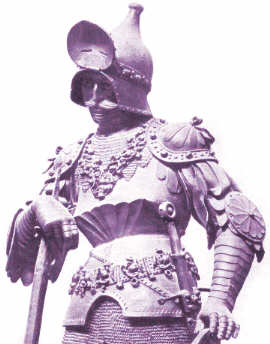 |
Hardcover Edition, 2005
|
|
301 pages [ISBN
978-3-86582-044-1]
|
|
€ 19,90
|
|
bsaw.de
|
|
[Shipping only within Germany.]
|
Hardcover Edition, 2007
|
|
574 pages [ISBN 978-3-86582-589-6]
|
|
€ 24,90
|
|
bsaw.de
|
|
[Shipping only within Germany.]
|
|
This
saga is one of the greatest sagas which have been written in
German language...
Here you can
hear
about those
occurrences by narration of German men, even by a lot born in Soest
where
those actions took place, who have seen unbroken the places where those
occurrences happened, where Hǫgni (→Hagen) fell and Irung was slain,
and the
Snake
Tower wherein Gunnar (→Gunther) had to face his death, and the garden
that is
still
called Niblungs Garden. And all’s standing in the same place as in
former
times when the Nibelungen were slain; even the gates: the eastern gate
where the battle began at first, and the western gate called Hǫgni’s
Gate
which the Nibelungen broke down into the garden; all that is called
similarly
as it happened formerly. Even those men told us about it who were born
in Bremen and Münster Castle. They did not know of each other for
sure, but all of them told about it in the same way. Most of it does
even
correspond with old German ballads by wise men who rhymed about the big
events that happened in this country.
Þiðreks saga.
|
| Multiple medieaval manuscripts are providing stories
about the Nibelungen.
An army of merited and self-appointed experts has been attempting to
take out the historical core of such literary renditions. However, all
these specialists soon must state that they have
to do with uneasy unravelling ‘adaptation on adaptation’.
Nonetheless, only a few philologists have been
contributing outstanding results
to disentangle this most popular German saga:
In 1931 Prof. Aloys Schröfl submitted that the
second part of the Nibelungenlied, known as Der
Nibelunge Nôt (Grimhild’s revenge and the Nibelungen
Downfall), cannot be the right sequel of the first (Sigfrid’s life and
death) for legendary coherency, because the
second one appears initiated by Pil(i)grim
von Aribon, Bishop of Passau on the Danube in 10th
century
for his special political ambitions in the Ottonian German period.
(Aloys
Schröfl: Und dennoch –
die Nibelungenfrage gelöst, 1931; Der
Urdichter des Liedes von
der Nibelunge Nôt und die Lösung der Nibelungenfrage,
1927.)
The lay actually refers to some topical cultural and
political contexts of 10th century, which,
however, had become less significant or obsolete already in
12th/13th century.
Furthermore, considering connotative
cultural and historical environment of Ottonian Empire,
Schröfl claimed at hand of the 13th-
century Nibelungenlied conclusive circumstantial evidence remaining in
its stanzas that
Pilgrim obviously intended to use a former contemporary version as ‘the
carrot’ for the
court of Hungary. With it, as Schröfl conjectures, Pilgrim
intended to enlarge his influence on this country
that was about to be christianised. According to this certainly
interesting context, the putative Ottonian version of the lay
could have been created to glorify the ancestors of the Hungarians and
might be evaluated today as an early political flyer.
The lay’s eldest extant manuscripts or ‘redactions’,
that might have been renovatingly written in the time of Wolfger
von Erla, Bishop of Passau, seem to reveal that this ‘regenerated
poetry’ came
into fashion at the beginning of the 13th
century. Thus, regarding characteristic plagiarism or ‘copying’,
assimilation and assemblage of compiled mediaeval
heroic epics, the postulated prime version must have been
transformed to ‘updates’ due to the spirit of high mediaeval times.
Yet, Schröfl’s research into the politico-religious
10th- century relations of German
Empire with Hungary is mainly focussing on connective approach
to motive and authorship which,
however, has been either scholarly suppressed or apodictically
negated through non-convincing Germanistic evaluation. Nonetheless,
Schröfl fairly underlined that the previous
creators of the Nibelungenlied are explicitly quoted in its Lament
work KLAGE as Bischof Pilgrin von Pazzowe
and his Master(-writer) Kuonrat.
Karl J. Simrock, well-known German translator of the Nibelungenlied,
has already connected both names with heyday of Upper German Clerical
Poetry of 10th/11th
century.
According to the studies of the most important 13th-
century manuscripts
made by the journalist and book author Walter Hansen (Die Spur
des Sängers, 1987,
p. 221f.), the narrative topographical details provided with the
verses on Kriemhild’s journey to Etzel may
intriguingly point to the poet’s location in today’s Low Austria,
whom he identified with Konrad von
Fußesbrunnen (re-)creating the lay in behalf of bishop
Wolfger von Erla.
Moreover, the literary scholar Peter H. Andersen, Prof. PhD, University
of Strasbourg, has recently recognized this Chuonrat von
Fuozesbrunnen as the most likely author, who already rhymed the
more than 3000 verse epic Die Kindheit Jesu and a secular
work in Wolfger’s time: Nibelungenlied
und Klage: eine niederösterreichische Doppeldichtung? in: Die
Bedeutung der Rezeptionsliteratur
für Bildung und Kultur der Frühen Neuzeit (1400–1750).
Beiträge zur sechsten Arbeitstagung in St. Pölten (May
2019), pgs 451–510.
However, due to research findings on the Nibelungenlied
and
the Dietrich von Bern poetry, a distinction must also be made
between archaic sources and contemporary motif structures that were
specifically implemented into the redactions of the high mediaeval
Nibelungenlied.
Heinz Ritter († 1994), philologist from
German
Schaumburg
on the Weser, seems to have uncovered the historical core of the ‘real
Nibelungen’
by his impressive publications and lectures. His long and meticulous
work,
done over many decades, led him to various Nordic texts, especially to
the manuscript known as Old Norse Membrane
(perg. fol. nr 4,
usually completed with younger Icelandic texts) and two Old Swedish
manuscripts which he
shortly called Svava. As
Ritter points out, these texts cannot
refer
to Theodoric the Great of Ravenna, but rather an equally named
Franco-Rhenish
king of Germanic Migration Era who had his first residence somewhere
between the Eiffel and the Rhine.
The Svava (or the Didrikskrönikan)
and the Membrane, popular name of the eldest extant manuscript of the Þiðreks
saga, provide narration about the historical Nibelungen, as
classified by progressive research that follows H. Ritter
(‘Ritter-Schaumburg’).
The Svava reports shorter than the more longwinded narrating Membrane,
but
both
versions relate quite more objective than the so-called MHG (Middle
High German)
sources. The archaic version of both manuscripts was certainly known
either before
or in the era of Charlemagne who had initiated the recording of
historical
traditions to great extent, as Ritter argues in his book Sigfrid
ohne
Tarnkappe, 1992.
This book reveals a very imposing correlation between
action
and topography
related to the Nibelungen, Sigfrid’s life and death.
The basic Evaluation of the Nordic
Manuscripts
Ritter’s
method of dealing with the Þiðreks saga is principally based
on his answer to the cardinal question whether a
tradition being assumed remarkably pregnant with historical
facts may be dissected in twilight mixture of mythological or
fabulating
narratives. As Ritter has expressively underlined at his
lectures, rather less significant as well as detectable
noncontemporary adapting implementation by an evident group
of Old Norse editors might have induced the majority of scholars
to estimate the Þiðreks saga basically as less authentic or
fabulous pool
of originally unrelated single tales. Furthermore,
Ritter regards the source of the Old Swedish manuscripts
principally ‘guiding’ Þiðreks saga, and he considers these
texts of such recognizable literary style and selectivity which
subsequently may allow efforts to estimate them as
historiographical sources.
Theodore M. Andersson, reviewer of a symposium based
supplement edited by Susanne Kramarz-Bein for Walter de Gruyter’s
encyclopaedia of Germanic antiquity, comments the contradicting
cataloguing of the Þiðreks saga.
Andersson was apparently remembering
Ritter’s publications with this introductory remark of 1996:
»...Þiðreks
saga, which had not
received much scholarly attention for several decades,
came back into fashion about ten years ago...«
This
English review, available at http://userpage.fu-berlin.de/~alvismal/7susanne.pdf
(retrieved
May 2005), follows Heinrich Beck’s general position by means of (e.g.)
his
paper Þiðreks saga als Gegenwartsdichtung?
who, stringently against Ritter’s postulation and reasoning,
notoriously exposes the Þiðreks saga to the light of poetry
which appears somewhat and somehow inspired by history. Andersson
writes:
Heinrich Beck’s
"Þiðreks saga als
Gegenwartsdichtung?"
(...) points out that Þiðreks saga (...) synchronizes events
from legendary prehistory with near-contemporary events
in the twelfth century (campaigns against the Slavs on
the eastern frontier of Germany). Time in Þiðreks saga
is thus a variable quantity...«
Moreover,
Heinrich Beck classifies the message of Þiðreks saga
expressively more subtle than its naïve reader would
imagine. Obviously addressing Ritter, he underpins Germanism’s
fundamental attitude toward the general understanding of
SAGA with this manifesto:
»Germanistic
saga research has recognized long since (...) that saga
tradition is not an ancient forwarding but derives from topic
adoption.«
(Transl. from Zur
Thidrekssaga-Diskussion, in: Zeitschrift für deutsche
Philologie. 112, 1993, pgs 441–448.)
However, Ritter’s research does not disregard the fact that the Old
Norse scribes evidently processed to title translated historiographical
and chronicled material as ‘saga’.
Thus, in so far, critical research would be not satisfied
with some subtle or at least ‘very interpretative’ explorations of the
Old Norse
texts which have been provided by Heinrich Beck and other scholars
Ritter’s translation of the Old Swedish ‘Didriks chronicle’ was
not called in question on literary subject. For elaborating
research he therein left his comparing analysis of both
chronological and historiographical structures of the Svava
and the Þiðreks saga manuscripts. In the addenda provided
with
his translation (pgs 399–455) he calls into question
the Svava’s dependency from the Membrane
and Icelandic manuscripts against scholastic
evaluation of mainly Scandinavian researchers. He also implemented
into his posthumous publication Der Schmied Weland
exemplary synoptic studies that point out the different literary
styles of these texts which, for instance, provide the
Þiðreks saga’s predilection for certain subjective notional
forwarding and, presumably, for mythologizing.
Seasoned practitioners have not rejected Ritter’s methodical
deciphering of the geographical and ethnic names in the Didriks
Saga, an analysis of noteworthy consistency that considers
rational contemporary circumstances of time and location. In 1959
William J. Pfaff had already introduced an equally titled book
with a geographical study in Germanic heroic Legend, who, however,
failed in
geostrategical plausibilities when turning to the less believable
Ostrogothic milieu, as this has been scholastically but
undifferentiatedly attributed to the texts by means of Upper German
poetry in particular.
As regards the source material of the Þiðreks saga, there is
no evidence that the Old Norse
editors had done essentially more than a mere translation of an
imported tradition which appears as a Low German Historia
Dietrich von Bern
– even considering that, apart from only a (very) few cases of
Ostrogothic misunderstanding and misinterpreting, the translators
obviously never attempted to change the most important location names
which have been re-allocated plausibly by Ritter.
To boot, it seems implausible that the Old Norse scribes of King
Hákon IV would have had any good reason to implant any own
narration or compilation on such unfamiliar small locations
as Vernica, Thorta, Brictan,
such rivulets as Duna, Wisara, Eydissa, such
mountain forests as the Osning
and Valslanga.
The Nibelungen Origin Place
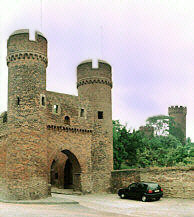 |
As Ritter refers to the Svava and the
Nibelungen by means
of his comprehensive publication Die Nibelungen zogen
nordwärts (Herbig,
1981), the Nibelungen home location as well as name giving to them will
be related to a rivulet called Neffel (*)
that springs in the outer
Eiffel near Zülpich. Thus, Ritter follows the localization of
Franz
Joseph Mone, Professor in history and eminent German philologist of 19th
century.
Zülpich:
Weihertor.
Photo by the author. Ritter identifies the Nibelungen residence on its
suburban location Virnich or Virmenich – on well known Roman main roads
of both Cologne–Trier and Cologne–Rheims. |
Mone explicitly favours the region of Neuss that, besides, the Frankish
historiographer Gregory of Tours
quotes Nivisium (Untersuchungen zur Geschichte der teutschen
Heldensage,
1836, p. 31f.) Henri Grégoire, another researcher and
philologist, has
connected
that subject with Nivelle, castle and town of Belgium. The
records
about persons of this place show epithet donation as Nivellung,
respectively Nibelunc (whom Charlemagne proudly called his
uncle),
as these names were given to Pepins in 7th
and 8th
century. (The Pepins were forming most influential ‘mayor-domus’ family
serving as Mayor of the Palace Charlemagne and other preceding
Frankish
rulers.) Grégoire, although trying a suspect relocalization of
Burgundia,
basically agrees with Emil Rückert who published in 1836 (in the
same
year as F. J. Mone) his ethnological and genealogical discoveries by
his
book Oberon von Mons und die Pipine von Nivella – Untersuchungen
über
den Ursprung der Nibelungensage.
Furthermore, Mone connects Gilibach rivulet, today called
Gillbach that springs
c. 20 miles to the north of Zülpich, with the original area of the
Nibelungen. The
district of
this watercourse was recorded Giliovi pagus, pago Gilegoui
in Middle Ages. Earlier spelling forms of this region called nowadays die
Gilbach are unknown.
Nonetheless, some reader may think of the origin location of Gibica
or Gibich, the
latter provided as Middle High German name of the ‘Nibelungen father’.
We may compare these name forms with the
Niflungen progenitor ‘Gjúki’provided by the Heroic
Lays of the Edda, and whom is said to correspond to ‘Gifica’
in the catalogue of heroes called Widsith.
Challenging the findings of Grégoire,
Ritter recognizes the historical seat of the Nibelungen just 80 miles
farther
to the east, since an eye-catching number of location names in the
region
of German Zülpich must be seriously taken into consideration for
verifying
those Norse-Nordic texts related to King Gunter’s family. For example,
there is an old place called Juntersdorf, formerly spelled
‘Guntirsdorp’
(dorp = village). The name of the Grimhild’s
and Gernholt’s
maternal grandfather King Yrian (Irian), as provided by the Old
Swedish
manuscript A,
seems to correspond
well with a former location Iriniacum.
Heribert van der Broeck, author of 2000 Jahre Zülpich
(Publisher:
Kölnische Verlagsdruckerei, 1968) ascribes this name to a Celtic
individual Irinus. The
manuscripts remark also
that
Hagen’s father was originally spelled Elf, Elff(e) or Albe,
as this name appears closely related to Elvenich. In former
times,
this place was testified as Albinacum or Albihenae.
Van der Broeck
reckons this location to a Celtic place of worshipping, since those ‘nich’
or ‘ich’
endings are very typical for Roman-Celtic
influence
on contemporary spelling.
Old settlements called Vernich
(etymologically
based
on a Roman
fundator called Varinius?), Virnich (at Zülpich-Schwerfen) and Virmenich
(now Firmenich) can be found there. These names correspond well with
the
Nibelungen residence originally spelled Vernica, Verniza, Vermintza.
Ritter does also detect a correlating basic item which
indicates the region of
Zülpich as the original home location of the historical
Nibelungen: The
manuscripts
note brightest full moon night when this folk met the Rhine at Duna
Crossing
on their fateful march to Grimhild and her spouse Atala (‘Attila’,
Old Swedish Aktilius, Atilius, Icelandic MS B: Attala),
king of that part of Saxony which
the Old Swedish scribes call Hunaland:
Since important campaigns were usually planned to start at full moon in
Late Antiquity as well as mediaeval times, the Nibelungen with
polished
armour underneath their garments could have covered only c. 30
miles
from
their capital place!
The Nibelungen region of Zülpich and Nivisium,
recognized by Ritter,
Mone and other researchers, formerly pertained to eastern Frankish
territory.
Regarding spatiotemporal history, a 5th–6th-century
ruler called King Sigebert – Gregory of Tours remarked him ‘the
Lame’ – was residing at Cologne before he was eliminated by Frankish
king
Chlodovocar I (‘Clovis’). The Waltharius,
a
poetry definitely elder than
the
Nibelungenlied, titles the Nibelungen as leaders of a Frankish tribe.
Thus,
we should make an effort to encounter Meroving(ian)s
by the Svava in the early history of the Franks.
Regarding research into the early history of Pepin Family, some more
interesting indications should be considered for correlation with the
Nibelungen
history:
| 1. |
The Pepins are undoubtedly
related to the region of Zülpich.
For example, a former church of Juntersdorf (Guntirsdorp) was dedicated
to their patroness Gertrud of Nivelles. |
| 2. |
The Svava and Membrane texts note Hagen’s son
Aldrian,
the only known
descendant of the Nibelungen, as a long living successor and ruler of
their
realm. |
| 3. |
The western borderline of the Nibelungen realm
was not
noted, but Sigfrid
(Aldrian’s slain uncle) could be considered heir of maternal family
property.
|
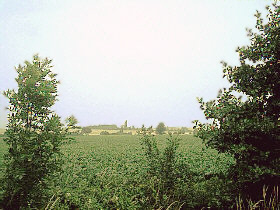 |
|
|
Juntersdorf:
A view
from the Neffel to the landscape.
|
Virnich.
|
|
Photos by
|
the
author. |
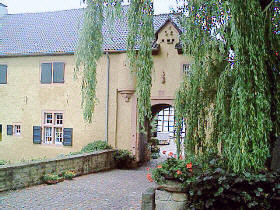 |
|
Irnich, suggested by Ritter, but etymologically less likely.
|
Virmenich
Castle.
|
The Svava quotes about the last ride of
Nibelungen
– the
undercover
campaign to their downfall – with this text:
...so they rode to the
Rhine, where Duna meets the
Rhine...
The Duna may not be taken for the Danube in this
connection,
rather
for Dhünn river (recorded as Duone in 1117) falling
till 1830/1840 into the Rhine at Leverkusen, the town to the north of
Cologne.
Incidentally, Ritter underlined this location as an important crossing
point
in former times.
The Niflungen then moved to Margrave Rodinger's seat.
Just south of the Dhünn dam was an early medieval settlement at Bechen.
A Bekelar
or Bechelar – name-giving was
the once
flowing Beche there – results with the ending ‘lar’ in preferred
meaning for a mostly water-related or swampy forest area. The other
local meaning of this old-language ending refers to a delimited area.
This Beche, so the medieval
place name, had a special strategic importance, because here was a
roadblock, a border marker in the form of a modernly called Landwehr on the old
army route from
Cologne via Wipperfürth to Soest. So we may this
location compare with the derivation of (lat.) Praeclara for
Pöchlarn to Bechelâren
on the Danube, as
propagated from the Nibelungenlied as the literary original. The
Germanist and Scandinavian medievalist Andreas Heusler recognized in
the Þiðreks saga, respectively its source material, a
preliminary stage of the Nibelungenlied, cf. Hans Peter
Wapnewski, Deutsche Literatur des
Mittelalters. Ein Abriß. Göttingen 1960, p. 71.
Other researchers generally agree with Ritter. For
example, Walter
Böckmann,
book author and documentary film maker, and Ernst F. Jung, historian
and
philologist, largely share Ritter’s revision of a more authentically
appearing
history of the Nibelungen or Niflungs. The Germanist and medievalist
Roswitha Wisniewski
found narrative
indications that
in
first half of 13th century a comprehensive
manuscript,
dealing
with the vita and epoch of Dietrich von Bern, was transferred
as
a chronicle from Westphalian monastery Wedinghausen to
Scandinavia
where it was re-narrated by Old Norse and Icelandic writers, as the
authoress
notes well in her postdoctoral thesis. As already mentioned, these
mediaeval scribes used to title imported historiographical material as saga.

|
|
Soest
by Merian.
|
The Svava: Sigfrid
(‘Sigord’)
and the
Nibelungen
A short summary
Note: ‘Svava’ means the
the region of the northern Suevi whose settling territory might
have
included the region between Bode and Saale rivers in Migration Period.
| Sigfrid’s father Sigmund is king of Tarlunga.
(Nowadays, the
Low Saxon towns Wolfsburg and Braunschweig may be found in this
region formerly called ‘Darlingau’ and ‘Derlingau’.)
Sigmund enters in matrimony with Sissibe,
daughter of King Nidung
of Haspengau: Hesbaye, the region on the Meuse (Maas)
between
Namur and Maastricht. King Sigmund receives the half of King Nidung’s
realm
as gift. Sissibe, however, becomes victim of an intrigue initiated by
the
noblemen Hartwen and Herman. King Sigmund, who went out
to
warring, had appointed them to his representatives. However, Hartwin
will
annex Tarlunga with Sissibe for his spouse – but she refuses all the
time.
The counts pretend infidelity of Sissibe to their returning king who,
deeply
shocked, allows them to abandon her somewhere in a woodland. There, on
a river, she gives birth to Sigmund’s son. Hartwin will cut out her
tongue,
but his accomplice Herman will not agree with mutilation. In the end,
he
can behead Hartwin in a fierce fight who, however, has kicked the baby
– embedded in a vessel of glass – into the river. Sissibe, mentally and
physically stressed, dies of shock.
A hind finds the baby and breastfeeds it. Then a
smith called Mymmer (Mime) raises the
child
the Old Swedish texts call occasionally Sigord Swen1.
Sigfrid’s choleric nature is certainly basing on
frustration by the ‘gilded cage’ his childless foster-father Mime2
has obviously made for him. At the forge, he lets off steam by beating
up Mime’s best foreman. Mime has also to recognize that his huge
and
strong adoptive son would never become a good smith. Moreover, Mime’s
customer
Queen Brynhild (Brynilla or Brynilda in the Old
Swedish texts)
seems to attract his pet. In the end, Mime has to admit
that he cannot hold Sigfrid any longer, but he rather wants him dead
than
having lost: So the sly smith sends Sigfrid for charcoal burning to the
area of Regen3,
who was believed Mime’s brother as well as man-killing
dragon-worm.
Sigfrid meets Regen and kills him. (The cheeky
young man
certainly knows
that there is no witness to confirm his version that the bloody
brew4
from Regen has made his skin not only horny and invulnerable, but also
sharpened his mind to understand bird language.)
Sigfrid brings Regen’s ‘special head’ to Mime and
tells
him to pick
it. Mime, however, is tremendously afraid of expecting Sigfrid’s
revenge.
Therefore, he promises him a precious armour he has just made for a
king,
his best sword Gram(er), and Grane, a stallion
from the
stud
of Queen Brynhild.
Sigfrid takes the byrnie that Mime puts him on.
The
smith also hands
him over the sword, but Sigfrid swings Gram to kill his
foster-father.
Thereupon he violently enters Brynhild’s castle
to get
the stallion.5
After he has killed seven gate guardians and scuffled with the queen’s
knights and squires, she manages to stop him. Much impressed by the
intruder,
she sends for the stallion and enlightens Sigfrid about his
descent.
Sigfrid moves with Grane to Bertanga,
a spelling form of German Bardengau,
today the region between Hamburg and Wittingen on Elbe river. He there
takes up service at King Isung who allows him to bear his own
shield
banner, which shows a dragon, in half red and half brown, on red
background.
King Theoderic of Bern6
(Didrik by the Svava)
receives information about Sigfrid’s power
and heroic actions. He makes up his mind to go out and measure himself
against him. These are some of the Twelve of his followers: Gunter
(in the manuscripts Gunnar), king of the Niflungs
(Nyfflinga, Niflunga), his brother Gernholt,
both sons of King Irung (Mb 2), and their half-brother Hagen,
the Old Norse Hǫgni7. Heim the Magnanimous,
or the Fierce,
is mentioned as a relative of Brynhild. His blue shield shows a
stallion. Wideke,
son of Weland, is the owner of Mimming (Mimung), the
legendary
sword
already made of hardest steel. Incidentally, as the Didriks chronicle
also
remarks,
Sigfrid’s cockiness had turned out Weland, creator of Mimung,
from
Mime’s smithy.
Didrik camps within sight to Isung’s castle8.
Sigfrid masquerades as modest horseman and rides down to spy them out.
He demands an appropriate present (‘toll and tribute’) from the
arrivals
for his king. Didrik’s noble knights throw dices for it, and Sigfrid
receives Amling’s horse and shield. However, Amlung follows
King Isung’s special
agent with Wideke’s white horse Skimling to get back his own
whatever
may come. Sigfrid defeats Amlung as they meet in the woodland nearby.
He
discloses his identity to his pursuer, and gives back the horse to its
owner because he remembers Amlung’s father Hornboge as
good
kinsman. Wideke had also recognized Sigfrid, but both do not report on
this incident to the Franco-Rhenish king.
King Isung agrees with a tournament. He nominates
his
eleven sons and
Sigfrid. Didrik cannot defeat him with his sword on
first
and second day. Therefore, he goes to Wideke and insists on handing
over
the Mimung. At the beginning of the third day of tournament, Didrik
swears
off to use that sword, but takes it nonetheless.
After King Didrik has seriously hit Sigfrid five
times,
the beaten recognizes
the wilful deceit and surrenders. For all that perjury, Sigfrid freely
offers his service to the Franco-Rhenish king.
Sigfrid enters in matrimony with Grimhild
(Crimilla in the Old Swedish texts)
by instigation
of his new king. As doing so, Sigfrid receives the half of the Niflungs'
realm that King Didrik has promised him.9
King Sigfrid, just married, loves to be the broker
for
the marriage
of King Gunter and Brynhild. This service is delicate insofar as
Sigfrid
had sworn her faithfulness before his own marriage, and so she gives
him
now a good talking to his broken oath of love!
The kingly marriage was performed between Gunter
and
Brynhild, but she
successfully refuses every night. Gunter confides his problem to
Sigfrid
who discloses that she might lose her power at her first physical
contact.
Gunter thus entrusts Sigfrid with further proceeding. However,
Brynhild
does not refuse against Sigfrid.
Grimhild later finds Sigfrid’s trophy of that hot
lovers' tryst: Brynhild’s
ring. It triggers off dispute and deepest odium between Grimhild and
Brynhild.
In the end, basically in parallelism with the Nibelungenlied, Sigfrid
will
be killed by Hagen’s spear.
Grimhild swears revenge and marries King Aktilius
(in other texts Attala, Attila).
He is descendant of a mighty Frisian
ruler family and the ruler of a large region belonging to today’s
Netherlands and Low Saxony. Seven years
later, she attracts her brothers to meet her at the residence of her
spouse: Susa(t)
(Soest of German Westphalia), centre of the so-called Hunaland
or Hymaland.
King Gunter combines the great chance to take over
the
realm of his
brothern-law, although Hagen and Queen Oda warn him in vain. So the
Niflungs
finally accept the invitation and move out with 1,000 fighters. Hagen
meets
two fortune telling women on that ride at a river lake on the Rhine. He
slays them after a trivial dispute about their ominous prophecy, and,
only
a short time later, the ferryman at Duna mouth crossing point.
After a half day ride, the Niflungs meet Margrave
Rodinger (the Old Swedish Rodgerd)
at Bakalar (‘Becculær’, ‘Pæclar’ in the texts) that
Ritter
identified in today’s region of Bergisch Gladbach.
After a short stay they follow the Duna (dwna), passing Thorta
(Dortmund) on their route
to Susat. There the fate of the Niflungs is sealed in the
heavy
battle
against the folk of King Atala, who, nonetheless, must give the lives
of
4,000 fighters for his victory.
At the banquet, where Providence was tempted,
Grimhild
wins her little
son Aldrian to punch on Hagen’s chin for funny encouragement.
However,
the irritable Niflung becomes so tremendously enraged by the boy’s
action
that he beheads him and his tutor. In reply, King Atala gives
immediately
order to slay all Niflungs.
Already on the first day of the battle, Gunter
must
surrender to the fighters of Duke Osid, nephew of Atala.
They throw him into the Schlangenturm (Snake Tower,
apparently not far from the so-called Irungs Wall)10
by order of Atala, where the king of the Niflungs
dies.
Grimhild kills her brother Gislher (Gynter by the Old Swedish
manuscripts) by driving a burning log into his throat. She already did
the same to Gernhold who had been slain by Hildebrand (in the texts Hillebrand),
follower and advisor of Didrik.
Thereupon Didrik slays Grimhild on Atala’s
demand.
Hagen, seriously
wounded by Grimhild’s loyal follower Lord Irung whom he had slain,
surrendered to Didrik after
his last fight against the Franco-Rhenish king, who, nevertheless,
cares
well for him. Hagen wishes for a young woman to be his nurse. He is
able
to beget a son in the last night of his life, and hands over the keys
to
Sigfrid’s Hoard to the expectant mother of the child, a promised son to
be named Aldrian.
Young aged, about 12, Aldrian attracts King
Atala, his
aging foster-father,
to that three-doors treasury cave and locks him there. Thereafter
Adrian
reports this revenge of the Niflungs to Brynhild who rewards
him
generously. Then he takes over the Nibelungen realm as good king.
The location of the Niflunga Hoard11
was kept as a secret and the cave never entered again. Its position
cannot
be estimated being far from King Atala’s residence.12
|
Annotations: Questions & Findings
 |
Nordharz
Map of 1968 |
|
*
Neffel - Niflung
According to German Wikipedia ‘Neffelbach’ (retrieved
2012-07-26),
the name of this rivulet is based on Nevvel =
fog,
because ‘the banks
of this stream are frequently covered with fog in the morning’. A
legend rooted in the region of the rivulet’s source tells about two
influential underground dwarf rulers Niff
and Neifel.
Obviously picking up this context, the Nibelungenlied provides a more
or
less splendid allusion with two dwarves called Nibelung, father
and
son. The latter had a brother called Schilbung, possibly
derived from a
place named Schievelsheide nearby. Their father left
an immense treasure captured later by Siegfried.
Interestingly, the 350th stanza of the
Nibelungenlied reads Nebelkappe (= fog
cap)
instead of Tarnkappe (= stealth cap): ...with
it everybody could do anything of his courage
– apparently a further allusion to this Neffel region. (It seems also
comprehensible that dense fog can make particular smaller
creatures less visible.)
The author(s) of the
elder Waltharius,
Upper German poetry ascribed to 9th
or 10th
century, nicknamed the Nibelungen Franci nebulones.
A rather objective initial interpretation that unmasks the Neffel dwarf
legend follows ore processing being proved there at an early date, in
this
region already applied in Roman times. Thus, it seems consistent that
small people
simply called dwarves did their jobs in underground mining or
‘in the caves’.
And they might have been commanded by those potential, smart and
skilled
individuals of same body size who were masterly engaged in profitable
iron and fine art metal works.
Regarding the etymological side of word forms beginning with nifl-
, Jan de Vries rightfully connects original
meaning with both dark and foggy, as the former
adjective
might correspond well with traditional mining work in this region (J.
de Vries: Altnordisches Etymologisches Wörterbuch). |
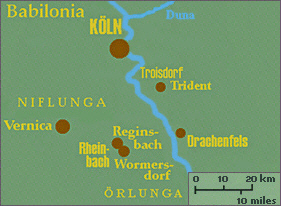 |
In comparison with Heinz Ritter’s localization of Sigfrid’s childhood
and
forging episode, dragon fight and treasure capture (see annotations 1
to 3),
the Neffel region as well as locations called Rheinbach (early
recorded as Reginsbach) and Wormersdorf,
both nearby, seem to gain in archaic background.  |
1 Sigfrid
His birth and fate as a baby appears as
an adaptation
of Frankish Genoveva legend enriched with motives of the birth of Moses
and the saga of Romulus and Remus.
Ritter pleads for the northern Harz as the venue of
Sigfrid and Mime the Smith, as he points out a deserted
settlement Siewershausen
(see X- mark on the linked Nordharz map) which was named originally Sigefrideshuson
maps.
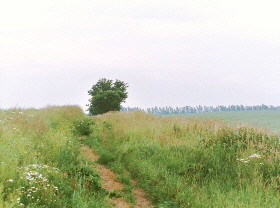 |
|
Siewershausen,
deserted
settlement. A view to SE.
Photos
by
the author.
|
Minsleben
– "Mynnersleben"
on the Holtemme rivulet.
A
view to
the mountains
where to find the rocky ground of Ilsenstein Castle.
|
Sigfrid’s Size
Mime takes a byrnie he has just made for a king, puts
it on
Sigfrid,
and it does fit. Moreover, it obviously fits so well that he can move
with
it to Brynhild’s castle. If he were aged as a boy, he could certainly
not slay seven guardians and go at loggerheads with some knights and
squires
on the queen’s castle. What are the mathematical probabilities that
both
the king and Sigfrid may have same size of just about a giant’s? There
is much impressing description of Sigfrid’s size, as Lord Brand recites
at the Grand Banquet for King Didrik’s followers and friends (Sv 177&178).
Does that speech might rather spring from boating yobbos who are much
overrating
themselves? Only a short time later these guys have go home with a
shaming
man-to-man result of a trial of strength at King Isung: They had lost
not
less than nine of twelve fights! Besides, Hagen and King Gunter were
defeated.
Didrik’s fight may be left aside here for his wilful deceit by broken
oath. 
2 Mime
Mime seems not to be an any old smith who has to do his
every
day’s job
for the villagers. Rulers of far regions obviously know about his
excellent works.
Sigfrid does not belong to the workers of Mime.
Obviously frustrated by hanging around, Sigfrid pokes his nose into the
smithy now and then,
where he does nothing else than vastly enervate and beat Mime’s
workers.
Just at that point, as Sigfrid was hardly to control for his enormous
puberty,
Mime is going to teach him working at the anvil.
According to early documented testimonies, a village
called Minsleben, a few miles far from Siewershausen, does
belong not only to the
eldest settlements of that region, but is also closely related to iron
works of early times. Ritter was witness of scientific diggings and
analysis
of ferrous slag found at Minsleben, whose suffix leben is a
derivation
from Thuringian leva or leven. Ritter
notes well that Mime was written down as Mymmer or Mynner
in
the Old Swedish manuscripts.
Another intriguing localization of Mime’s smithy has
been
pointed
out by
Rudolf Patzwaldt:
Referring to the Reginsmál and Fáfnismál
of the Elder Edda (Codex Regius), a ruler named Hjalprek
put Regin(n)
(intertextual
character corresponding with Mime) in charge of raising up Sigurð.
Regarding Ritter’s timline of Þiðreks saga, this Hjalprek
may
be considered as the early Salian king Childeric I. Both
historiographical
and poetical texts localize his activities also in Saxony and
Anglo-Saxon campaigns.
Following the texts written by Gregory of Tours, Childeric’s territory
or influence might
have included the Eiffel. Regarding that passage provided by
the Elder Edda’s lays, we could identify the
Eiffel locations Worm ersdorf
and Rheinbach, the latter formerly
certified as Regin(s)bach
(= ‘Regin’s rivulet’), as place of Sigfrid’s foster father. This
implicates in so far an important area of narration provided
by
some heroic lay of the Edda.
On the subject of the slaughter of Sigfrid, Patzwaldt
also
focuses on
intertextual etymological details provided by the Nibelungenlied and
Þiðreks
saga. Subsequently, he points out the Eiffel as more believable origin
location of some of the lay’s most dramatic parts. 
3 The Regenstein,
the venue suggested by Ritter
Seven miles to the southeast from Minsleben, the Regenstein
rises
up as a small woodland mountain with steeply ascending rocks.
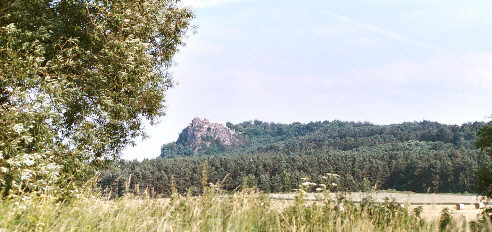
|
|
The
'Feuerland' forest
surrounds the Regenstein. Photo by the author.
|
Imposing caves are crossing the Regenstein foot area
that is
nicknamed Feuerland (Fireland).
They could have been serving for places of Germanic worshipping, e.g. Thing
ritual.
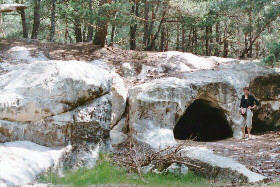 |
|
|
Photos
by the author.
|
|
Today, just a mile far from the Regenstein, ponds and
marshy
places
fill the little valley of Goldbach rivulet. Old land registry
maps
specify its parcels as Drachenkopf (Dragonhead) and Drachenloch.
The
latter, ‘Dragon Valley’, rolls approximately a third mile.
Forest
rangers of this district still use these names. Today, this area is
privately
run and restricted.
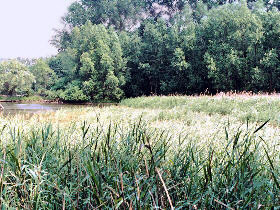 |
|
| The
impressing ‘Dragon Valley’ rolls about a third mile. |
Photos by the
author who thanks the proprietors of this
land for
the release of both photos. |
Was Regen a solitary protozoon or the Count of
Regenstein?
There might have been an ideal habitat for the first
named
possibility.
Although the manuscripts report on Regen as a brother of Mime, this
context
could mean spiritual brotherhood: Had Mime some slyness and cunning of
a reptile?
On the other hand, Hatebold alias the first Count of
Regenstein (s.
below), a homeless parvenu who recently had received that location
probably
without remarkable means, could easily and specially protect his area
by
making good use of the ghastly natural scenery surrounding his castle:
As most important performer, he just needed the completing ‘dragon’ to
horrify (and rob?) unexpected visitors – certainly by masquerade. There
are some tortuous items supporting such theory of an unreal dragon, cf.
original quotations in Sv 158 and Sv 304.
The German translation of the Vǫlsunga saga, 18,
quotes
this speech by the ‘dragon’:
Haven't you heard how
that all folk was afraid of me
and
my shocking
helmet?
[Translation by the author.
However, the Vǫlsunga saga translators
William Morris and Eirikr
Magnusson
(Walter Scott Press, London, 1888) like to give less exact translation
by this speech of Fafnir: Hadst thou never heard how that all folk
were adrad of me, and of the awe of my countenance?]
A robber masqueraded as a dragon, as some authors
conjecture,
would
never dare to chose his hidey-hole on the foot of a feudal lord’s
castle
or somewhere nearby; and a wary Mime, heaping up an enormous mass of
profit
by his ‘High-tech smith works company’, would never entrust neither a
robbing
kinsman nor any unfamiliar person with that means in order to keep it
far
away from his questionable or curious workers and, generally, any kind
of temptation. Nonetheless, Mime would certainly do accordingly with
his
brother who ought to meet contemporary VIP class as well: Regen – Count
of Regenstein.
The above mentioned passage of the Vǫlsunga saga
enlightens
us
on the incentive related to the smith and his brother. The latter or
the dragon-worm, basing on narration by Fáfnismál
of
the Elder Edda, makes this confession toward Sigfrid
who
has wounded him lethally:
I had on the shocking
helmet to protecting myself
against
all folk
for all the time I was keeping my brother’s heritage... so that nobody
else dared to approach me; no sword was frightening me, and I never
found
so many men against me, methought being much stronger than them, so all
were afraid of me ... (Translation by the author.)
However, the Vǫlsunga saga
provides a divergent
background
of the ‘brothers heritage’.
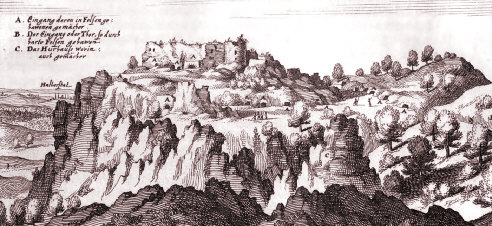
|
|
The
Regenstein with
its ruined castle by Merian, 1654.
|
|
There is historical narration about name
giving to Regenstein:
In 479
Malvericus, King of Thuringia, started a campaign against the Saxons.
However,
his army was beaten back at Veckenstedt (Veckenstädt) in the Harz.
There, a brave fighting nobleman called Hatebold was rewarded for his
service by the option to chose a piece of land for his own
residence.
When he
found the little rocky mountains, he shouted out: ‘This stone is
the
right (= regen) one for my home!’
After
he had built his castle there, he called himself ‘Count of Regenstein’. |
| |
| Source: Sagen
um den Regenstein by Hans Bauernfeind, Helga Sorge, Hermann
Wehr. Publisher: Schloßmuseum Blankenburg. |
|
Thus, the name of this location was contemporarily known. If just a
huge
reptile
were living at that time somewhere around the Regenstein, it could have
been
easily
named after the short name of its proprietor. 
4 Dragon’s
Blood on other spots
Regarding the legendary incredible qualities of
Sigfrid’s
skin, the
Svava itself qualifies all those quotations to a reasonable degree when
retelling the tournament fight against Didrik, where Sigfrid, even
protected
by a byrnie, must give up for his wounds!
Incidentally, by retelling his fable of the
‘Dragon Killer’ who
had taken that special bath from the beast’s bloody brew, Sigfrid
could certainly make some people believe to have become an invulnerable
superman
just by this thrilling excuse: As historians have noted, the
Merovings,
most important dynasty of early Frankish rulers, were tainted with
hereditary
skin disease called ichthyosis hystrix. Its most striking form will
make
human skin as thick as a swine’s rind. This seems to correspond well
with Sigurðr’s Old Norse apposition sveinn
which, however, is also the word just for a boy rather of bad
appearance.
This is translated text from the entry Drache
= Dragon
by German DUDEN, Edition 1969:
...The victory over the
dragon means victory over chaos,
darkness,
or an old order...
Thus, the dragon represents the bad – and he must not
necessarily come
out by its natural appearance! 
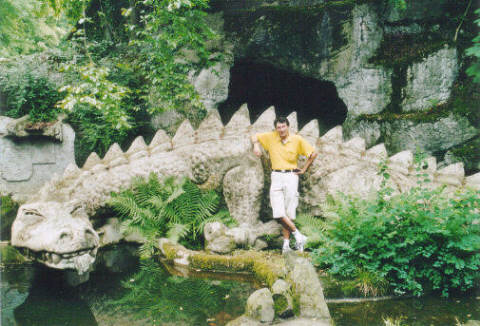 |
|
The
'dragon-worm'
as being placed on the Drachenfels ‘Dragon Rock’ on the Rhine.
|
|
Incidentally,
this
protozoon sculpture is a detailed reconstruction basing on real
skeleton
fragments preserved at Senckenberg Museum, Frankfurt, and the Berlin
Zoo.
|
|
Photo
by the author.
|
Francis P. Magoun Jr reinspected
the Old
Norse ‘itinerarium’ Leiðarvísir og Borgarskipan
written by
Nikulás Bergsson (Bergþórsson). The abbot
of Munkaþverá connected the Gnitaheiðr,
where Sigurðr killed ‘the dragon’ by
traditions based on the Edda
lays, with places called Horús
and, as nearest site to the venu, Kiliandr,
explicitly on a route between Pǫddibrunnar
(Paderborn) and Meginzoborgar (Mainz). The American scholar
recognized Horús as Horohusum at the
northeastern foot
of the Eresburg at Obermarsberg, its mediaeval
settlement now
deserted but already in a certificate by Emperor Otto I,
afterwards by
Henry II, cf. also
Hermann Oesterley, Historisch-geographisches
Wörterbuch
des
deutschen
Mittelalters, 1883: 302. Magoun thereby
hazarded the
hypothesis that
the latter site Kiliandr could be
identified with Kilianstädten on the Nidda (obviously
likewise Rudolf Simek, Altnord. Kosmographie, RGA Erg.-Bd.
1990:484; cf. a
review by Dominik Waßenhoven 2008:29–61).
Magoun estimates most tentatively that
this valley region with suggested mediaeval name forms like Nitahe
or Nitehe
might have stood for the heiðr’s
Icelandic understanding.
Nonetheless, we may wonder whether this location on the
Nidda does also provide a reflection of the eminent Nidhogg
of Old Norse mythology. Apart from that, however, we may take note of
E. C. Werlauff: The editor and publisher of
the Symbolas ad Geographiam medii ævi ex monumentis
Islandicis (1821) likes to connect Kiliandr
with Kaldenhart, the former name of Westphalian Kallenhardt,
east of Warstein (cf. below). Sigurðr’s
decision to slaying also his foster-father, the obvious
last confidant knowing of Fáfnir’s place of treasure,
could point to the plan to carry off the treasure impromptu and
secretly to a hiding place nearby.
Felix Genzmer
(Berlin 1927) supplements the slaying of Fáfnir with a
passage
taken from the Vǫlsunga saga which is quoted here with the translation
by Magnusson & Morris:
| Then Sigurd leapt on his horse
and rode
along the trail of the worm Fafnir, and so right unto his
abiding-place; and he found it open, and beheld all the doors and the
gear of them that they were wrought of iron; yea, and all the
beams of the house; and it was dug down deep into the earth: there
found Sigurd gold exceeding plenteous, and the sword Rotti; and thence
he took the Helm of Awe, and the Gold Byrny, and many things fair and
good. So much gold he found there, that he thought verily that scarce
might two horses, or three belike, bear it thence. So he took all the
gold and laid it in two great chests, and set them on the horse Grani,
and took the reins of him, but nowise will he stir, neither will he
abide smiting... |
The Leiðarvísir’s
intriguing passage was already challenged by Paul Höfer in 1888
and Otto Höfler (1959,1961,1978) who turn
to the
Battle of the Teutoburg Forest in order to identify Arminius with
Sigfrid and the ‘dragon’
with the Romans (most extensively Höfler). However, both scholars
and their modern followers propagate less convincingly the Knetterheide
at Schötmar (Bad Salzuflen) which is on a route
rather from Mundioborg (Minden) to Pǫddibrunnar
(cf. e.g. Heinrich Beck 1985:92–107).
The Vǫlsunga saga considers the Hindarfjall in
narrative
environment with both Sigurðr’s
fight
on the Gnitaheiðr and Brynhildr’s
seat. Regarding this geographical context, the author received between
March 2012 and 2014 an interpretation from the philologist and book
author August Hunt who follows Magoun on Gnitaheiðr and
estimates Seeburg on lake ‘Süßer und Salziger See’ as Brynhildr’s
primary residence. Mentioned in A.D. 1043 as lectulus
Brunhildi, the Großer Feldberg in the Taunus
mountains
does remember the heroine long since with the so-called Brunhildisfelsen,
c. 30 km (18 mi.) far from Kilianstädten. For the ‘Hirschkuhberg’ =
Hindarfjall
associated with Brunhild’s seat, there is also – only a few kilometers
east of Bad Honnef – at least a name similarity for a mountain that was
later renamed Himmerich; cf. Johann Joseph Brungs, Berg-
und Flurnamen aus dem Bereich des
Siebengebirges (1931) pgs 12–13.
Interestingly, as regards Sigurðr slaying Fáfnir
on Gnita heath, it
seems less likely that Nikulás had known the Nibelungenlied.
However, he notes the Italian thermae Þiðreks
bað at Viterbo (→
Bagnoregio,
formerly the 6th-century Balneum
Regium) which he quotes or suggests as a plausible
health resort of the Italian king Theoderic the Great. The Old Norse
scribe of the Þiðreks saga could have remembered this passage
of the Leiðarvísir
in so far,
albeit there were at least to well-known spas in the kingdom of
Frankish king Theuderic: Aquae
Granni (Aachen) and the thermae of Roma Secunda (Trier).
5 Brynhild’s
Castle
After Sigfrid had slain the ‘dragon’, he moved with a
byrnie
from Mime’s
smithy straight to Brynhild’s residence Seaguard'in Svava.
Ritter identifies
the smith near
the Regenstein on the north side of the Harz. Consequently, apart from
a possible seat in the Taunus and Seeburg
in northern Suebia of Migration Period (reasonably suggested by A.
Hunt),
the other nearest
castles would be either the Heimburg (H. Ritter) or Ilsenstein (W. Böckmann);
the latter on a mountain in the neighbourhood of the highest mountain
of the
Harz:
the Brocken with its marvellous sight-seeing place. Incidentally, the
Nibelungenlied
provides Isenstein as Brynhild’s residence. According to the
Old Norse Þiðreks saga, she had also a stud estate in the
forest
nearby, whose horses were much praised for their extraordinary
qualities.
Queen Brynhild is known as an orphan. Her uncle – who
rather
might be
her brothern-law – is Heim (the) Studder or Heimir.
He
runs her stud estate, as provided by the Vǫlsunga saga
that
nicknames Brynhild’s castle Shielded Castle or Castle of
Shields.
Its rocks photographed from the distance seem to resemble simple
shields
of Late Antiquity being heaped up irregularly. The position of Heimir’s
castle, the Heimburg which became related to German rulers
Henry
IV and Henry the Lion later on, can be verified by a large lake
– ‘sea’
(See) in German language – recently found subterranean only some
miles to the north, as the proprietors of Dragon Valley land
parcel
informed the author.
Nonetheless, Queen Brynhild might have had no reason to
give
up the I(l)senstein
after the death of her parents and move down to her bad- tempered
relative
on the lower Heimburg (Sv 14), as Walter Böckmann does also
believe.
This castle might belong to the queen’s real estates; but the
‘Isenstein’,
with its surviving rocks and longwinded access of nearly one mile, is
in
quite more representative landscape position.
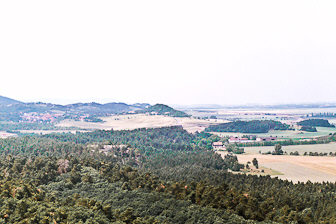 |
|
|
Amid
the photo: The
Heimburg cone at an important strategic position.
|
The
Harz rising behind
the Heimburg.
|
All
photos
by the author.
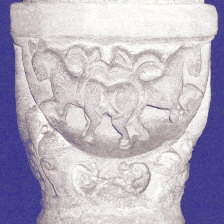 |
|
|
Horse
Capital of
Drübeck Crypt.
|
The
Heimburg by Merian,
1654. Ground
Plan
|
The traditional but peculiar horse breeding in
woodlands
and forests,
as Tacitus quotes in his Germania, ch 27, is also shown by the Horse
Capital at the crypt of Drübeck Cloister Church
founded c. 2 miles far from the Ilsenstein. Incidentally, the distance
from this place to the Heimburg is approximately 9 miles. 
6 Theoderic or
‘Didrik'
of Bern’
He was proclaimed King of Bern at an age below
20.
Already grown older, he has to flee to King
Atala who grants him exile at his Soest (Susat) residence
for a big threat coming from Didrik’s kinsman
Ermenrik. Now, in the period of deprivation,
Didrik seizes the opportunity to aid Saxon
King Atala warring against Baltic tribes. Thereafter he leaves
Atala’s court for a campaign against Ermenrik.
However,
the battle at Gransport on the Moselle’s mouth results in
Didrik’s
high personal losses. He moves back to King Atala and
renounces his restoration to the throne for the deaths of a
kinsman and two offspring of King Atala’s family.
Some years later, after the downfall of the Niflungs
at Soest, he leaves King Atala’s country for Bern where he
goes out
with his new army. He meets the troops of Sevekin, Ermenrik’s follower,
at Graach on the Moselle and
overthrows him. The scriptors relate that Didrik was immediately
crowned King of Rome (= Trier),
thereafter
ruling even a greater
realm.
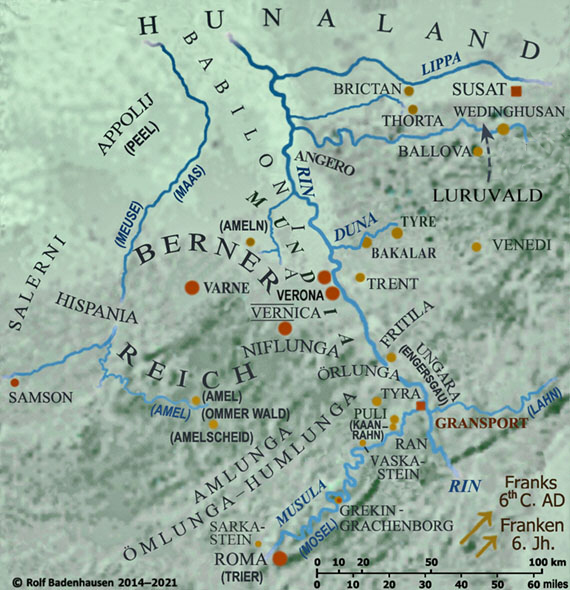 Some locations of Þiðreks saga
(Ritter and
other authors).
Some locations of Þiðreks saga
(Ritter and
other authors).
Ritter believes in Bonn on the Rhine as place of
residence of
young King Didrik. He argues that Bern is based on derivation
from
Latin Verona - Berona as handed down actually in the
Middle Ages
for Bonn on the Rhine. Nonetheless, we seriously have to consider
another
quite more precious ancient place for Bern: ‘Varne’, provable
short
spelling
of the Roman VARNENVM.
Another
location appearing between Atala’s residence and Didrik’s Bern is Babilonia.
It can be identified as Cologne on the Rhine by clerical messaging of 11th-German
century. Thus, the basic
connections
related to the vita of Franco-Rhenish king Didrik cannot be confused
with
those of Theodoric the Great. 
7 Hagen
Hagen’s father can enter the garden of certainly well
guarded
kingly
castle without any problems for a lovers' tryst! Therefore, he
certainly
had been introduced to the court, coming across with self-confidence
and
auspiciousness
as a druid (Sv 161). The appearance of a Celtic priest in the Eiffel
region
of the Niflungs might correspond with those typical
spelling
relicts in today’s location names there. The former location of Hagen’s
family, as provided by his name apposition he certainly had received
from
his father, is occasionally forwarded as ‘of Tröya’ (Sv 340) or
‘of
Troja’ (Þiðreks saga, Mb 395). However, it seems less
credible that
Hagen’s
ancestors were of Trojan origin or came from the Colonia Ulpia Traiana
of Xanten. We rather should consider Frankish Troyes,
Champagne-Ardenne,
outstanding Celtic location of the Tricassi.
The old spelling form ‘Hǫgni’, with a
lower-o-ogonek, is commonly typed ‘Hogni’. 
8 King Isung’s Land
... They were riding across large woodlands and
heaths ...
The Svava’s description perfectly corresponds with the
heath
lands of
German Lüneburg. Ritter estimates the kingly castle on the Kalkberg
of Lüneburg town.
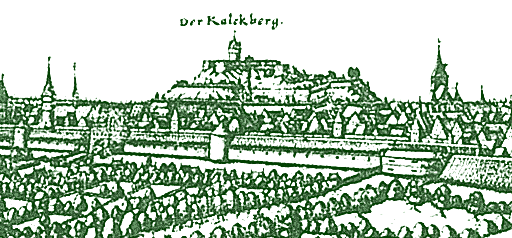
|
|
The
Kalkberg of Lüneburg
by Merian.
|
Incidentally, Sigfrid reports to King Isung that on the
shield
of one
arrival is also a lion of gold with a crown (Sv 185).
Since
there was no other subject mentioned afore being in connection with
this
symbol, it must be King Isung’s, too. Actually, we know dynasties with
a lion on their heraldic crests that have been ruling this region
between
Brunswick and Lüneburg. 
9 Sigfrid and
Grimhild
(and King
Atala)
The Svava does not report on any affections for a love
match
between
Sigfrid and Grimhild!
Due to Ritter’s timeline of the Didriks chronicle,
Grimhild
was aged
over 40 when she married King Atala. Considering a health-conscious
way
of life as well as corresponding genes, she could have given birth to a
child, the meaningful son of King Atala, just in time. Nonetheless, we
may wonder if the couple were willing to sacrifice him, probably their
only heir apparent, for the apparently planned provocation for slaying
the Niflungs. If they would not, any suitably aged son of King
Atala’s
concubine(s) could have been publicly introduced as Grimhild’s son.
As a heroic lay of the Elder Edda provides, Atli
let punish a
talkative
court-maid who alleged that Gudrun (= Grimhild) was sleeping
with Thiodrek
at Atli’s residence.
Regarding the pedigree of the Niflungs, as extracted
from
the
Svava and
Þiðreks
saga manuscripts, however, Grimhild’s youngest brother Gislher cannot
be the natural son of Queen Oda, spouse of the early died King Irung
(Mb 2; Mb 3: Alldrian), as
Ritter rightly stated. 
10 Schlangenturm
and Irungs Wall
A former existence of a pallatium sive turris
(residence building or tower), ‘occupied by reptiles and other
creatures’, is provable to
high mediaeval Soest. Regarding also its homgarðr, William
J. Pfaff
reasonably agrues (op. cit. p. 175) by means of Henrik Bertelsen’s
source
text transcription and Ferdinand
Holthausen’s Studien zur Thidrekssaga:
A
document on
the authority of the
archbishop of Cologne
(c. 1178) relates that a ‘palace or tower’ next to the old church of
St. Peter had been full of reptiles, etc., and was then being used for
charitable purposes, probably a reference to the Hohe Spital southwest
of the church. There is no trace of the Nibelung name; perhaps
Högnagarðr
(B) and Niflungagardr
were added when Hom appeared (for bom) and the
obscurity had
led to confusion
with Holm- (II,310) for Norwegian scribes. There is, however,
ample
evidence that the Norwegian was not inventing these details; Holthausen
(464) suggests that the Edda may have taken the snake-pit motif from
northern Germany.
Challenging Ritter, Dietrich Hofmann (Christian-Albrechts-Universität
zu Kiel, German and Scandinavian studies) introductorily
attempted to
indicate the possibility that the localities of Soest, as specified by
the
manuscripts, had inspired a high mediaeval narrator for a
pseudo-historical relocation.
However, Hofmann then turned to
considering that this ‘reteller’ – more likely – might have had
only very little or no knowledge of the exact townscape in much former
times and, therefore, had to refer to contemporary structural
development for an impressing imagination of a former 6th-century
Franco-Saxon battle. Proceeding form this constellation it seems less
probable that the composer(s) of the Atlakviða,
one of the eldest Eddic lays of around A.D. 900, had taken its ormar
garðr motif from an apparently later erected episcopal site pallatium
sive turris which
was reported unkempt and, thereafter, noted on its restoration in 1178.
|
| |
|
Hofmann therefore argues onto the main
pretensions that, first, ‘the people
of
Westphalian Soest had taken outlandish legends for own historical
accounts’ and, second, ‘they
had little
or no knowledge of their own history’:
|
| |
|
However, the two
statements are still to
be modified a tad. On the one
hand, we may assume that some people in Soest and elsewhere knew better
about the true history of the city than the narrator of the Niflungs
history. Because of the conditions of ownership, not only the
archbishop of Cologne but also the Soest clergy ought to have been more
accurately informed about the ‘snake tower’ than anybody else. It is
rather to be expected that the belief in the historicity of the
Niflungs history
as a local history of Soest should have been widespread and strongly
rooted in the people’s mind. Otherwise the narrator would not have been
able to express himself so convincingly, as this version had apparently
spread even far beyond Soest. Some ‘intellectuals’, on the other hand,
could not argue to the contrary. The oral tradition was a great power
in the Middle Ages because it was thought to be historical and largely
supported. There was no other form of historical tradition
since centuries – even millenniums. The gradually developed
written tradition was not accessible to most of the people. Thus, they
had scarcely any means of examining and correcting the oral tradition
in the matter of historical facts. For this reason, the statements made
above on the conception of history might not only concern the citizens
of Soest in 12th/13th
century, but generally the perceptive opinion of history in the broad
population of the Middle Ages.
Ritter is, to a certain extent, still right by further necessary
modification of the two statements. One must also query how it could
have happened at all that the Soesters had a reception of a foreign
legend as their own story. The existence of remains of old walls and an
abandoned tower in which snakes were living is by no means sufficient
to
explain this. We can only proceed on the assumption that old
traditions were extant in Soest and esteemed there as historical before
the reception
of the Nibelungensage; for instance, stories about a mighty king in the
pre-Christian era, about heavy fighting on the western wall at the old
fortifications of the inner city, etc. Similarities in the course of
action
and the constellation of persons could have led to the fact that the
Nibelungensage, spread mainly by minstrels all over Germany and beyond,
was identified in Soest with stories of own tradition, presumably with
ballads. Of course, identical or similar names of acting persons could
significantly induce the identification and therewith the reception of
the Nibelungensage.
From this point of view it is by no means absurd, albeit purely
hypothetical, to argue with the name At(t)ano on
the disk fibula,
dated into the end of 6th century, as Ritter
has
done it, see pp. 207f.
In the Middle-Low-German period, the name would have developed to the
form *Attene
which might well have given an inducement to
an
identification with Attila. This, incidentally, is a literary
influenced form which shows that in Þidreks saga’s presentation a
portion of scholarship was involved who,
however,
obviously did not affect the believe in the correctness of the oral
tradition (…) Of course, as regards the Soest part of the
Niflungs history, comparably the same influenced constituents being
localized in other
places
and regions of Westphalia and the Rhineland, on which Ritter’s book
as
well as his previous treatises provide important awarenesses. It seems
clear
that the stories could also have gotten into the influential circle
of the Nibelungensage which, however, had no inherent correspondences
such as, potentially, a local tradition about the walled-up dead in the
Kallenhardt cave ‘Hohler Stein’ in the Sauerland, and which could have
been transferred to Attila.
|
| |
|
(Dietrich
Hofmann, “Attilas
Schlangenturm“ und der “Niflungengarten“ in Soest in:
Jahrbuch
des
Vereins für niederdeutsche Sprachforschung, 1981, vol. 104, pgs
31–46. Translation from pgs 44–45.)
|
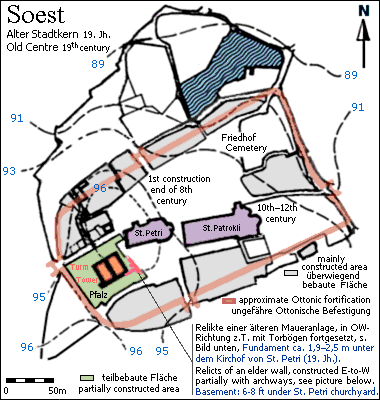 |
|
A plan with
contour
lines of
the old centre by municipal registry of
1830. Hofmann refers to a corresponding reconstruction drawing by F. W.
Landwehr, see p. 40. See Ritter 1981:193 who does not estimate the
large
building at the episcopal place of residence ‘Pfalz’ as Gunnar’s
‘snake tower’, see also pgs 199–203.
According to the manuscripts Hǫgni had left in Soest the obvious most
impressive actions, as these are his bursting through the western wall,
fighting ferociously against Irung and then Þiðrek, and,
finally, generating a son for revenge on the patron, ‘father’ or ‘Ata’
of Soest.
Since the place of Hǫgni’s ancestors has
been suggested at Troyes, we should think more complexly
about the reasons why Archbishop Bruno of Cologne had the mortal
remains of St. Patroclus transferred from Frankish Troyes
via Cologne to Soest as its new Christian
patron. This ‘installation’ extended from 962 to 964. |
|
| |
|
Dr Heinrich ten
Doornkaat
Koolman, a former Mayor of Soest, wrote on the obvious relicts of an
elder or, relatively, the eldest known wall:
|
| |
Wie
in der Zeitschrift des Soester
Geschichtsvereins
Nr. 14 Seite 22 ff. berichtet wird, kamen 1884 bei den
Ausschachtungsarbeiten für ein neues Pfarrhaus an der Ecke des
Petrikirchhofes und der Hospitalgasse alte Mauerreste zum Vorschein.
Gücklicherweise hat man den Fund sorgfältig aufgemessen, und
eine von dem Baumeister Lange am 16.7.84 angefertigte
maßstäbliche Zeichnung ist in dem Heft 14 S. 24/25
wiedergegeben.
Danach hat eine von Norden nach Süden
verlaufende, 1,80 m in die Tiefe reichende Mauer den Petrikirchhof von
dem zum Hohen Hospital gehörenden Gebiet geschieden. In einer
anschließenden von Osten nach Westen verlaufenden, aus
großen behauenden Quadern aufgeführten Mauer von reichlich 1
m Dicke befanden sich unter der Erdoberfläche zwei etwa 2,20 m
hohe und etwa 1,80 m weite rundbogige Torbogen. Weiter befand sich
ein Haufen Bauschutt untermischt mit Resten verkohlten Gebälks.
In dem Bericht ist weiter vermerkt, diese Mauer
müsse zum Hohen Hospital in Beziehung
gestanden haben,
wenn sie auch keineswegs einen Teil des Gebäudes gebildet habe.
Dafür, daß dies nicht der Fall gewesen, spreche die
völlige
Verschiedenheit des Mauerwerks.
Dies Alles deutet auf eine ältere
Burganlage hin, die vor der Errichtung der merowingischen Pfalz
bestanden hat.
(Heinrich ten Doornkaat Koolman, Soest
die Stätte des Nibelungenunterganges? Rochol, Soest
1937, see pgs
10–11.)
Drawings on the right are taken from the article quoted by
H. ten Doornkaat Koolman.
|
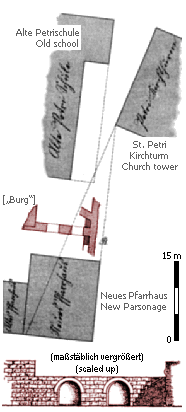 |
|
[Transl.:
As reported in the magazine of the Soester
Geschichtsverein, No. 14, page 22f., 1884, old fragments of the
wall came to light during the
excavation work for a new vicarage at the corner of the Petrikirchhof
and the Hospitalgasse. Fortunately, this find was carefully measured,
and a scaled plan drawn on 16 July 1884 by Mr. Lange, master builder,
is reproduced in issue 14, pgs 24–25.
According to that a wall extending from north
to south, reaching a depth of 1.80 m, separated the Petrikirchhof from
the area belonging to the Hohen Hospital. In an adjoining wall
extending from east to west, not less than 1 m in thickness and
consisting of large chiselled cuboids, two bows of arched gates, c.
2.20 m high and c. 1.80 m wide, were found under the ground. There
was also a heap of building rubble mixed with the remains of charred
timberwork.
The report also notes that this wall must
have been related to the Hohen Hospital, even though it was by no means
a part of the building, as this might be supported well enough by the
complete difference of the stonework.
All this points to an older fortification
which existed before the erection of the Merovingian Palatinate.]
|
| |
|
Ritter supplements
on this article an obvious later excavation, ‘commissioned by the Historischer
Verein
of Soest in 1951/1952’ as he writes, whose experts had uncovered a wall
(c. 2.5 m
thick) even under the foundation level of the Pfalz. Ritter
summarizes that
the archaeologists of this excavation found under this wall strata with
remains of
carbonized
material and scattershot skeleton fragments and, thereupon, drew the
assumptive conclusion that on this location ‘heavy combats had taken
place in the
early Middle Ages’. Ritter quotes as follows from its report (1981:198)
by
Hubertus Schwarz: Soest in seinen
Denkmälern, Soest 1955, p. 134:
|
| |
Unter den Fundamenten (…)
fanden sich unter einer gleichmäßig waagrechten,
tiefschwarzen Holzkohlenschicht von 2 cm Dicke in 1,30–2,30 m Tiefe
(…)
»in
ihrer ganzen Stärke, besonders aber nach unten
hin, wahllos zerstreut, menschliche Knochenreste, die zumeist, auch die
Schädel, zertrümmert und zum Teil auch angebrannt waren. In
2,20 m Tiefe konnte noch eine 1–2 cm starke, scharf abgesetzte
Holzkohlenschicht festgestellt werden, unter welcher unmittelbar wieder
menschliche Schädel- und Knochenfragmente lagen. Da diese
Schichten nur an der Südseite der sogenannten ›Wittekindsmauer‹
auftreten und noch weiter in die Tiefe gehen, liegen sie im Innern im
Keller eines alten Bauwerks, das als Vorläufer des ›Hohen
Hospitals‹ (= Veste) angesehen werden
muß.«
(…)
»Das ganze
Auftreten dieser Schichten mit ihrem auffallenden Inhalt in den Kellern
eines Bauwerks, dessen Mauern 8 Fuß =
rund 2,50 m
breit waren,
läßt an dieser hervorragenden Stelle des alten Burgbezirks
schwere Kampfhandlungen im frühen Mittelalter
vermuten.«
|
| |
|
[Transl.:
Downward the foundations (…) under a deep
black
charcoal stratum of 2 cm thickness, running undisturbed horizontally at
a depth of 1.30 to 2.30 m were found (…)
«in
all of its
dimension, increasingly downward, randomly
scattered human bone remains and skulls which were smashed and partly
burned. Further, then at a depth of 2.20 m, a sharply stepped 1 to 2 cm
thick charcoal stratum was localized again with fragments of human
skulls
and bones. Since these strata were found only under the south side of
the so-called ‹Wittekindsmauer› and lie farther in the depths, they
meet the inner domain of the basement of an old structure which must be
regarded as the previous building of the ‹ fortification =)›
‹Hohen Hospital›.»
(…) «The whole appearance of these strata, with their
striking contents in the basement of a building, whose walls were
8 feet or 2.50 m wide, admits to presume heavy fighting in the
early Middle Ages at this eminent place related to the old
fortification.»]
|
|
11 Sigfrid’s Niflunga
Hoard
The hoard, most probably a cave, should meet these
requirements:
| 1. |
This location must be easily
reachable from
starting point,
King Atala’s residence, for a twelve years old boy and an elder man on
horses, but without an escort or entourage. |
| 2. |
The position and inlet of the cave must not be
found
with ease in the
natural environment. |
| 3. |
The cave must contain mortal remains of a man
covered
with earth or
other natural material after passing one and a half millennium. |
| 4. |
The position of the dead body must not indicate a
burial. |
| 5. |
The dead may not be as died young. His date of
death
must be verifiable
to pre-christian time of that territory. |
| 6. |
Considering the secret trip to the cave, the
remaining
personal accessories
of the dead must be ascribable to a ruler of 6th
century. |
A cave which meets these conditions was found in a rocky
hill at
Kallenhardt, Warstein,
in 1926:
In the tunnel of that Hohler Stein (‘Hollow
Rock’),
mortal remains
of a man were found in an undisrupted stratum. The procedure of a
burial appeared impossible for the position and environment of the
remains. The age of the dead man was determined
to
nearly 50. The jewellery found at his skeleton, which are a rune
fibula, an arm
ring,
a finger ring and knobs, are preserved today at North-Rhine-Westphalian
museums of Lippstadt and Münster.
Prof
Stieren and Dr Julius Andree directed this
exploration.
On the next official excursion (made in 1933) relicts of
a forgery of the Thirty Years' War were found at the western inlet of
the cave that still has an
unspecified
number of tunnels. As Ritter notes in his book on the Nibelungs'
history,
Dr Andree informed him that Prof. Stieren certainly had suppressed
much
onto the Kallenhardt
discovery.
Heinz Ritter-Schaumburg wrote
on July 7, 1987, this supplement
related to the dating of the bronze finger ring found at the skeleton
of the dead man in the tunnel of the Hohler
Stein:
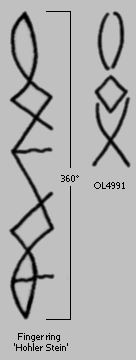 Sources: Sources:
Hans Schumann (2016, Repro of finger ring ATM unverified). OL4991
specifics notably by Peter Pieper (1987, 1989), Martin
Findell (2010). The
carvings on the finger ring may be compared with those of the rune bone
OL4991 (partial view) found on the Lower Weser at Hammelwarden, Brake.
|
. |
Der
verschwundene Bronzering mit der »Kreuz«-Verzierung
ist wiederaufgetaucht. Er befindet sich jetzt im Museum in Olpe
(Sauerland).
Er wurde von dem Archäologen Dr. Hömberg als »ein
üblicher Ring des 6. und frühen 8. Jahrhunderts«
eingestuft. Damit gehört
er in die gleiche Zeit wie die Funde in den Soester
Frauenkammergräbern. Bisher hatte man die Fundstücke
im Hohlen Stein in die Zeit um und vor Christi Geburt datiert.
Das trifft also auf den Bronzering nicht zu.
Im übrigen kann ein Schatz, den »viele Könige und
Herren zusammenbrachten«, auch sehr alte Stücke
enthalten haben.
Den Ring umlaufen 6 Einritzungen,
fünf Schrägkreuze
und ein Schrägstrich. Das können keine Verzierungen sein,
weil ihnen die Regelmäßigkeit fehlt. Auch die
Schrägkreuze sind ungleichmäßig: die Striche sind
verschieden lang und die Schnittpunkte
einmal mehr auf dieser Seite und dann wieder mehr auf der anderen. Sie
berühren sich auch nicht. Ich halte sie daher für Runen. Es
ist die Glücksrune X (G), wie sie auch auf der Soester
Rundfibel eine wichtige Rolle spielt, und sie ist also etwa
gleich alt mit den dortigen Runen. Es sind 5 Schrägkreuze, so
viele, wie der Fibel-Name ATANLO
Zeichen hat, und es könnte eine Beziehung zu diesem Namen gemeint
sein. Der Schrägstrich beendet diese Reihe und ergänzt zur
Sechszahl. Der Ring ist ein Hinweis dafür, daß zwischen
den Geschehnissen im frühen Soest und denen im Hohlen Stein eine
Beziehung besteht.
However, as contextually
remarked in the German article, it seems less likely that the mighty
king of Soest had worn a bronze finger ring instead of e.g. a golden
one. |
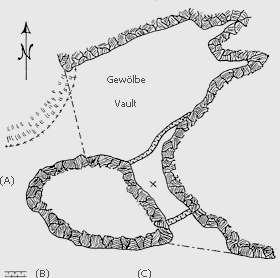 |
|
| Bricked
wall x
Position of the dead man |
A
|
| Author’s
copy from the cave’s ground plan by Eberhard Henneböle, local
historian. |
Photos by
the author. |

12 Graves, Soest 6th–
7thcentury
If survivors of the Soest Battle had wanted to leave a
solid
message
about those dramatic events to the far posterity by the techniques of
that
era, they surely must have resigned themselves to do so by gravely
limited
choices.
At that time, in other epochs as well, characteristic
features
of eminent leaders were often expressed by precious burial objects,
nonetheless –
fortunately.
Which would be the least significant arrangements if to
proceed to the ruling class of Soest in this way?
| 1. |
No male kingly burial
chamber since Atala died in Sigfrid’s
treasure cave. |
| 2. |
Since Aldrian, the obvious son of
Atala
and Grimhild,
died early by
Hagen’s sword, his grave must be found close to one burial
chamber of a noble woman. |
| 3. |
Regarding an important symbol for
King
Atala’s death, one female burial chamber, that of the concubine
who shared with Hagen his deathbed, ought to contain a piece that
either shows or is a key. |
| 4. |
The female burial chamber of
previous item
should
contain otherwise or in addition a symbol expressing an
intimate ratio for the generation of Aldrian, designated avenger
whose father’s coat of arms features an uncrowned eagle. |
|
|
In springtime of 1930, less than one mile south of the old town
centre
of Soest, a burying place was found at excavation work for a
prospective
building. Prof. August Stieren directed also these diggings and
examinations
of this discovery. Its basic properties, at least partially reckoned to
Frankish
burying,
are meeting the aforesaid conditions: For instance, there was a small
male
but distinguished burial chamber, archaeologically catalogued as a
boy’s grave No.
17,
between two noble female chambers (No. 106 and 105).
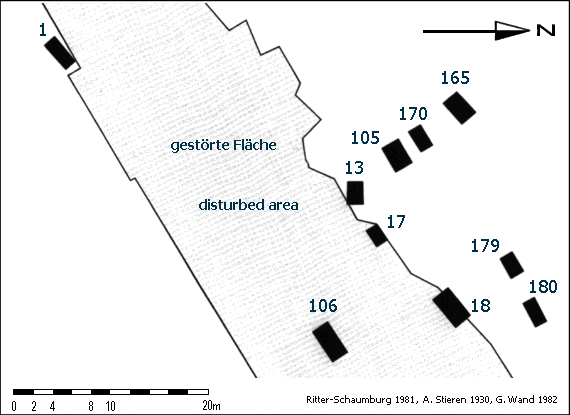 Soest
Chamber
Graves: 1, 13, 18,
165, 170, 180 are
female. Male chamber 179 is
less precious for minor weapon parts of iron. Soest
Chamber
Graves: 1, 13, 18,
165, 170, 180 are
female. Male chamber 179 is
less precious for minor weapon parts of iron.
According to conclusive indication based on strontium isotope analysis,
the female chamber No. 106 belonged
to woman who grew up in the area of Soest. Thus, this
chamber seems not to be Grimhild’s final resting place.
Nonetheless, this item does correspond with two Old Norse
traditions, the Atlakviða and the Atlamál,
which relate that Grimhild = Gudrun survived the battle of their
brothers against the Hunas at the seat of her husband Atli. According
to the Atlakviða and also the later written
Vǫlsunga saga, she got married a third time. However, the
scribes of the Nibelungenlied maintain that Grimhild was killed by
Hildebrand, but according to the Thidrekssaga and the Old Swedisch
transmission she said to be slain by Dietrich himself. It therefore
seems obvious that her death was made up by the authors of these
traditions.
Prof. August Stieren estimates that some of these wooden burial
chambers must have belonged to a
burial
mound. Furthermore, prints of a wooden bench were incontestably found
in the female chamber No. 105. Hence, this chamber could have been
accessible
for
a certain period after the time of burial. As regards numismatic
dating, a coin or some other burial gift could have been deposed
later. Some German criticism against Ritter levelled
at the key or other grave goods of chamber No. 105
(cf. items 4–5, a picture of its amulet below) appears inconsistent,
however: The key could be
either a symbolic replica or the death and burial of the involved
person took place after Aldrian’s revenge.
 |
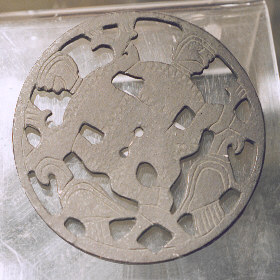 |
|
Top
picture on the left:
The medallion (c. 10 cm in diameter) of burial chamber No. 105
which
also contained an iron made key.
Top picture on the right: The filigree disc fibula of grave No.
165 (c. 3.5 cm in diameter).
Both photos by the author. |
|
| Pictures
below: Golden Cloisonné rune fibula of chamber No. 106 and its
contour sketch
from
the reverse (c. 5 cm or c. 2 inches in diameter). Several rune-reading
analysts read the cross-type engraving A-T-A-N-O
or A-T-A-L-O.
(See also: Further
information to read the fibula.) |
|
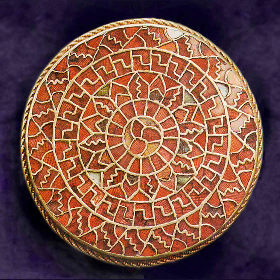 |
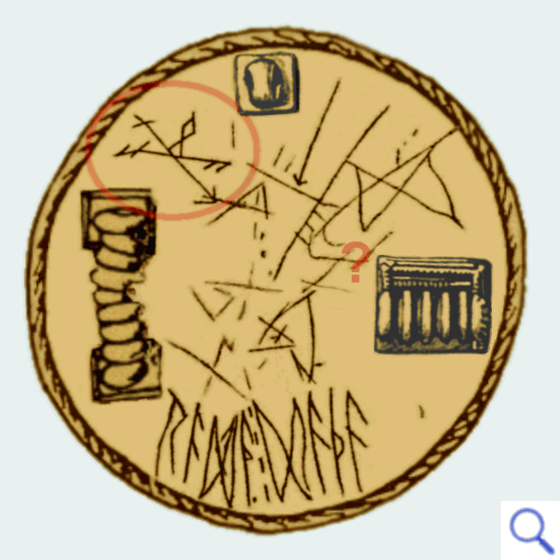 |
|
Final Remarks and Reactions
In comparison with MHG works
such as the
Nibelungenlied, the
Old Norse
and Swedish manuscripts appear as objective as a police report.
Further, as regards historiographical and bibliographical
characteristics
of
mediaeval literature, we should seriously question whether
stylistically drier
traditions
were serving for rather embellished adaptations of sophisticated
epic
poetry. Thus, some literary research has come to realize that the
author of the Nibelungenlied would have thought hardly of any atavism
back
to literary style of Þiðreks saga. In contrast, the
old philological view that the
historical core of the downfall of the Nibelungs should represent the
defeat
of the Burgundian king Gundahari in 435/6 against Western Roman and
Hunnic troops appears as a not necessarily
convincing monocausal appropriation – at least because of the
research-ideological connection of this folk with a rhyming epic that
moves the venues to a more southern region.
Ernst F. Jung, historian in
Roman and
early Merovingian history, has evaluated the research of both Ritter
and Roswitha Wisniewski. He points out the most significant difference
between
the
Þiðreks
saga and the Nibelungenlied with this statement:
The historical
panorama
of space and time ‹ of both transmissions ›
is absolutely unlike. The
Þiðreks saga
relates
chronicled
events being connected with North-Rhine Westphalia while the
Nibelungenlied
is basing on poetical fantasy playing at the Danube ...
[„das
Gesamtpanorama raumzeithistorischer Art ist ganz und gar verschieden.
Die
Ths. spielt auf Chronik-Basis in NRW, das Nl. als Spiel dichterischer
Phantasie
im Donauland ...“]
Jung quotes in his publication Der
Nibelungen Zug durchs Bergische Land
(pgs 113–114) from a paper Merkblatt
by Ritter (dated
1985-12-26) which he subtitled Die
Überlieferung der Thidreks saga resp. Dietrich von Bern
und die Nibelungen
(cf. original German text):
The
so-called Thidreks saga or Didrikschronik is a report about
events of past times, which take
place in the Low German area. It is preserved only in the Old Nordic
languages, but emphasizes in various passages that it comes from German
sources and is based on Old German lores, which were written soon after
the reported events. These tell of the life of the legendary king
Dietrich of Bern, whom Upper German tradition likes to equate with the
Gothic king Theoderic the Great. A part of the saga also tells of
Sigfrid
and the Nibelungen-Niflungs, who perished here in Soest.
The Thidreksaga gave some riddles. Many of its
details were not understandable. Especially the much disputed passage
about the ride of the Niflungs belonged to it, as it tells this:
'Thus they rode always their way, until they came to the Rhine, there
where Duna and Rhine meet'. Whoever started from the Nibelungenlied,
understood the Danube under the 'Duna' and sensed
geographical ignorance. Therefore, the Thidreksaga was believed to have
been created by an unsuspecting Nordic 'saga man', who in the 13th
century, with the help of German tradesmen in the old Hanseatic city of
Bergen, had compiled the oldest Thidreks saga manuscript, the so-called
'Membrane'.
But that venue was not meaningless; the Thidreks
saga rather meant the North German area. Really, the Dunfluss, today's
Dhünn, flowed into the Rhine at Wiesdorf-Leverkusen, and ancient
ferries and fords are attested at this point. The naming of this spot
proves exact knowledge of this area in early times, and all allocations
of the Thidreks saga are correct to it. This place is a pivotal point
for the understanding of the Thidreks saga. From here the Niflungs
ride, passing Thorta castle (Dortmund), to Susat (Soest) and perish
there in wild battles.
(Note
by Jung: H.
Ritter's researches ultimately revolve around the literarily and
historically significant question: which is the original, historically
significant source of the German heroic saga: the Nibelungenlied or the
Thidreks saga Chronicle? He comes to the conclusion:)
The Thidreks saga
was proved as the mother of
all saga tradition...!
Especially the places mentioned in the Thidreks saga
refer to a very early time. They all are very old. None of the many
cities, palaces and abbeys founded by Charlemagne appears in the
Thidrek saga. This means that the Thidreksaga knows only the
pre-Carolingian state of these areas.
But old are especially the name forms of the
Thidreks saga. 'Thorta' is one of the oldest names of Dortmund.
'Ballofa' corresponds to the oldest name form of Balve. 'Brictan'
(north of Dortmund on the river Lippe) is the early form of the place
name Brechten, the former centre of this whole area. Tyr, Ram, Puli'
are very old forms of names, and the name of the Niflungen castle
'Vernica' goes back to the Roman 'Verniacum'.
Regarding compound name forms, the Thidreks saga
knows only the oldest ones: many with -borg, two each with -stein
(sten), -fils, -gard, one each with -saela, -lar, -port (on the
Moselle), none with -dorp (except for a late mention in Denmark), one
with -heim (south of the Moselle), but none of the later so common
compounds with -ingen, -hausen, -hoven, -weiler, -rode, -bach, -tal,
-berg, -feld, -bruch, -scheid etc. This means: The Thidreks saga has a
very old name stock, which could not be taken up in later centuries.
From all this it is to be concluded that Thidreks
saga's tradition must originate from the time before Charlemagne.
(Note by
Jung: There is no
doubt about
the saga's statement that
it is derived from Old German lores, which originated soon after the
narrated events. In the end, they lead back to the time of the Frankish
land seizure at the turn of the 5th to the 6th century.)
Rather, Charlemagne let
collect and and write down lores in German, which in his time were
already
regarded as 'antiquissima carmina', that is, as 'ancient'. In these
lores the deeds and wars of the early kings are sung about. But exactly
these make the contents of the Thidreks saga: the deeds and wars of the
early kings. And it is inconceivable that such exciting and dramatic
reports as the downfall of the Niflungs should not have been among
these traditions.
So it is incorrect to speak of the
'emergence' of
the Thidrek saga around 1250 and to assume a 'Norse saga man' as the
creator of the Thidreks saga. Whoever does this defends a point
of view
that has been overcome and shows that he has not taken note of the ‹ my
› foregoing studies that have been available since 1979. The Thidreks
saga is a German tradition of pre-Carolingian times. This is the
core
thesis of my books.
It follows by the way that hat king 'Dietrich of
Bern' – living and acting in this Low German environment – cannot be
Theoderic the Great, the Huns (hynir) cannot be the southeastern Huns,
the king Attala-Attila-Atilius coming from Frisia cannot be the Hunnic
king Etzel. I have shown in detail that not the Burgundians but only
the 'Niflungs' can be meant, and their castle should be called
'Vernica' but not Worms.
After all it is self-evident that the Nibelungenlied
cannot have been the source of the Thidreks saga. It is much more
probable that, conversely, the Thidreks saga's tradition was the main
source of the Nibelungenlied and other medieval epics.
Thus, at least two contexts may be additionally
queried to the myth of the Burgundians and the Huns, which has been
widely
praised by poetry and philological research:
| 1. |
According to the 5th-century
historian Olympiodoros of
Thebes, in 411 the Alans leader Goar and the Burgundian leader Gundahar
elevated the Gallo-Roman Jovinus to their counter-emperor at Mundiacum in the province Germania II. However, this place
name was reinterpreted as ‘Moguntiacum’ for ‘Mogontiacum’ =
Mainz. This was done however without regard to the probability that
Frankish-Burgundian peoples could have settled (also) the Germania II. Thus, it seems obvious
that Mundiacum cannot be
ruled out as a name patron for places
there, such as Mündt and Müntz in the region
Mönchengladbach–Jülich.
|
| 2. |
The herioc poem Waltharius, written in the 10th
century before the available manuscripts of the Nibelungenlied, refers
to a Gibbich (‘Gibicho’ in
the poem) as the father of Gunther
(‘Guntharius’) from the tribe called Franci
Nebulones. The poet of the Nibelungenlied, however, does not
make Gibbich a Burgundian,
for he refers to Dankart as
the father of the royal siblings. This genealogical constellation also
speaks for different spatiotemporal narrative relations between the
Thidrekssaga, the Waltharius
and the Nibelungenlied.
|
This context was approached remarkably early. For instance, Julius R.
Dieterich connects Mundiacum to the region of
Müntz, north of Jülich, as
the area of a more probable Burgundian settlement region of the 5th
century in his publication Siegehard
von Lorsch – Der Dichter des Nibelungenlieds (Frankfurt / Darmstadt
1923). He further refers to the possibility
that the ‘authoritative writer’ of the Nibelungenlied, whom he
estimates
at the monastery of Lorsch, may have borrowed the heroic seat of Worms
from the Waltharius, the long
known poetry at that time. One year after Dieterich’s contribution
followed the more text-critically cited publication by Reiner
Müller: Die Burgunden am
Niederrhein 410–443 (Jülich 1924).
Some historical and current philological
receptions:
The
Old Norse and Swedish texts compared with eastern Frankish history
Regarding the martial expeditions provided by the
Þiðreks saga and the so-called Svava, Ritter ascribes
the basic chronospatial accounts of these
manuscripts to
5th–6th
century.
The Frankish expansion of power in the early 6th
century to the region of Cologne, notably the treacherous murder of the
Rhenish king Sigebert, that was schemed in secret by Merovingian king
Clovis I
and carried out by middlemen or noble confidents on the hunt (cf.
Gregory of
Tours), may not be disregarded in view of a historical relevance of the
Niflungs' campaign. This report must therefore
by no means be excluded as the historical basis for Sigfrid's slaying.
This period does also concern the reign
of Theuderic I, the eminent eastern Frankish
successor
of Clovis. After
their military campaign in southern Gaul against the Visigoths, which
ultimately
failed, Theuderic was in narrative offside over a longer period of time
to our accredited historians; but then this Frankish Dietrich
re-appeared as a mighty ruler of the Franks. According to
archaeological findings and reliable historical facts, in Theuderic’s
reign significant Frankish migration and invasion movements took place
in Central
German areas which extended over today’s Low German and Hessian regions
to Thuringia and the western
Harz foreland. These movements, notably appearing at the end of the
first third of 6th century, were continued by
his successors.
The period between
Clovis' takeover of Sigebert’s kingdom of Cologne and the Thuringian
campaign of the Frankish Dietrich indicate clearly the eastern Frankish
expansion period. Accordingly, the Niflungs – marching at that time
into a
Westphalian region to be conquered – are nowhere called ‘Burgundians’
in the Þiðreks saga and the Swedish texts.
The Atlakviða, the oldest
tradition of the fall of the Niflungian duo Gunnar and Hǫgni, calls
Gunnar a 'vinir Borgunda', a 'friend' (!) of the Burgundians. This also
convenes with Clovis' reign, in which Franks and Burgundians fought
together against the Visigoths in 507/508 and finally against the
Ostrogothic king Theoderic the Great, who had moved as far as to
southern
Gaul for military support.
With a fundamental research perspective and
parallel on Ritter-Schaumburg's analysis of the Þiðreks saga,
the Germanist Hilkert Weddige quotes his fellow researcher Reinhard
Wenskus on the connective heroic figure Iring in historiography and
heroic tradition (Heldensage
und Stammessage, Tübingen 1989, p. 69). Wenskus
assumes direct influences of historical reality on the transmission of
heroic sagas. These were ‘living traditions of certain groups of
people, whose history was also reflected in the further developments
and variants’. The source material may include the Upper German
Nibelungen and Dietrich epics to a certain degree.
The philologist Hanswilhelm Haefs (Thidrekssaga und Nibelungenlied,
2004) has critically questioned Ritter-Schaumburg's findings about the
historicity of the Þiðreks saga. Also according to this,
Haefs rejects the highly stylized claim that Ritter basically ignores
reliable literary-historical findings about the saga and real history
of the Germanic-speaking peoples. He rather points out that such
oppinion appears as an uncritical sweeping judgment that lacks a
differentiated examination of his research.
By means of linguistic research and localizations from historical
sources and oral traditions, the historian and medievalist Hans Georg
Kirchhoff comes to the conclusion that a Lower Rhine homeland seems
more probable for the Nibelungen-Niflungs than the Burgundian Worms.
Heinz Ritter’s bibliographical work instigated
some remarkable reactions published
by private researchers. One of the most interesting contributions,
apart from some attempt to emendate him for some more or less
controversial attitude, was written
by Rudolf Patzwaldt (see above). He also provides a captivating
intertextual analysis of some geographical items related to the
Nibelungenlied and Þiðreks saga.
Heinz Ritter was honoured with German Bundesverdienstkreuz
(Federal Cross of Merit) and the Verdienstorden
des Landes
Nordrhein-Westfalen
(Order of Merit of North-Rhine Westphalia) for his life’s work.
Appendix
|
|
|